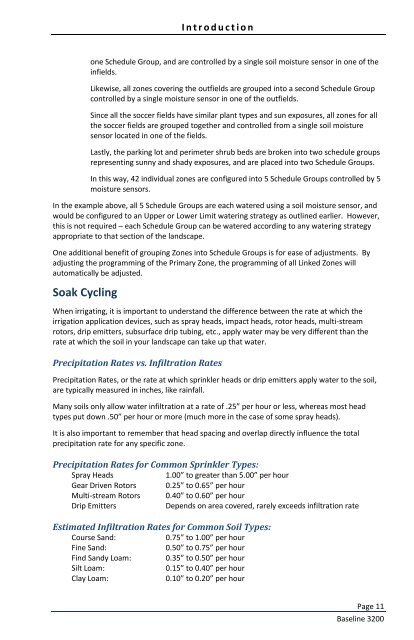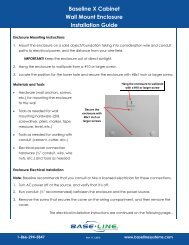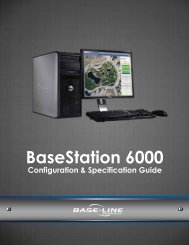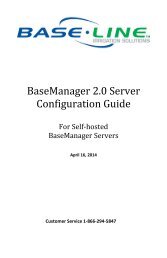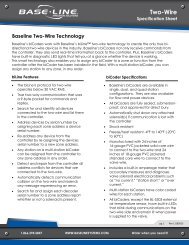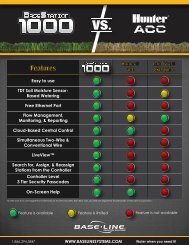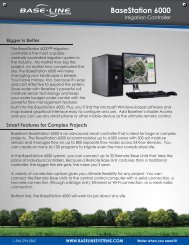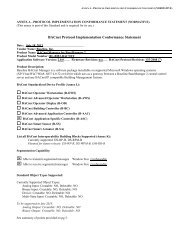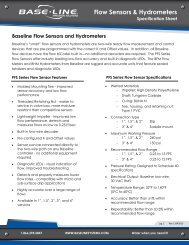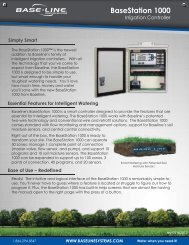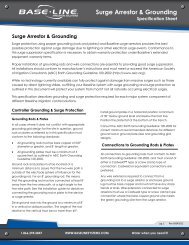BaseStation 3200 User Manual - Baseline Systems
BaseStation 3200 User Manual - Baseline Systems
BaseStation 3200 User Manual - Baseline Systems
Create successful ePaper yourself
Turn your PDF publications into a flip-book with our unique Google optimized e-Paper software.
I n t r o d u c t i o none Schedule Group, and are controlled by a single soil moisture sensor in one of theinfields.Likewise, all zones covering the outfields are grouped into a second Schedule Groupcontrolled by a single moisture sensor in one of the outfields.Since all the soccer fields have similar plant types and sun exposures, all zones for allthe soccer fields are grouped together and controlled from a single soil moisturesensor located in one of the fields.Lastly, the parking lot and perimeter shrub beds are broken into two schedule groupsrepresenting sunny and shady exposures, and are placed into two Schedule Groups.In this way, 42 individual zones are configured into 5 Schedule Groups controlled by 5moisture sensors.In the example above, all 5 Schedule Groups are each watered using a soil moisture sensor, andwould be configured to an Upper or Lower Limit watering strategy as outlined earlier. However,this is not required – each Schedule Group can be watered according to any watering strategyappropriate to that section of the landscape.One additional benefit of grouping Zones into Schedule Groups is for ease of adjustments. Byadjusting the programming of the Primary Zone, the programming of all Linked Zones willautomatically be adjusted.Soak CyclingWhen irrigating, it is important to understand the difference between the rate at which theirrigation application devices, such as spray heads, impact heads, rotor heads, multi-streamrotors, drip emitters, subsurface drip tubing, etc., apply water may be very different than therate at which the soil in your landscape can take up that water.Precipitation Rates vs. Infiltration RatesPrecipitation Rates, or the rate at which sprinkler heads or drip emitters apply water to the soil,are typically measured in inches, like rainfall.Many soils only allow water infiltration at a rate of .25” per hour or less, whereas most headtypes put down .50” per hour or more (much more in the case of some spray heads).It is also important to remember that head spacing and overlap directly influence the totalprecipitation rate for any specific zone.Precipitation Rates for Common Sprinkler Types:Spray Heads1.00” to greater than 5.00” per hourGear Driven Rotors 0.25” to 0.65” per hourMulti-stream Rotors 0.40” to 0.60” per hourDrip EmittersDepends on area covered, rarely exceeds infiltration rateEstimated Infiltration Rates for Common Soil Types:Course Sand:0.75” to 1.00” per hourFine Sand:0.50” to 0.75” per hourFind Sandy Loam: 0.35” to 0.50” per hourSilt Loam:0.15” to 0.40” per hourClay Loam:0.10” to 0.20” per hourPage 11<strong>Baseline</strong> <strong>3200</strong>


